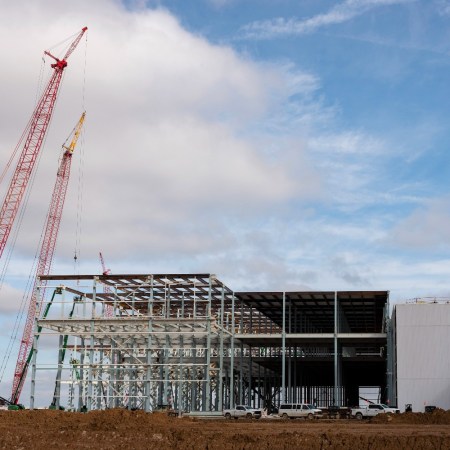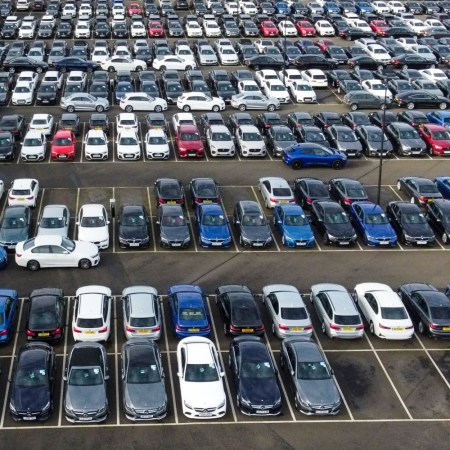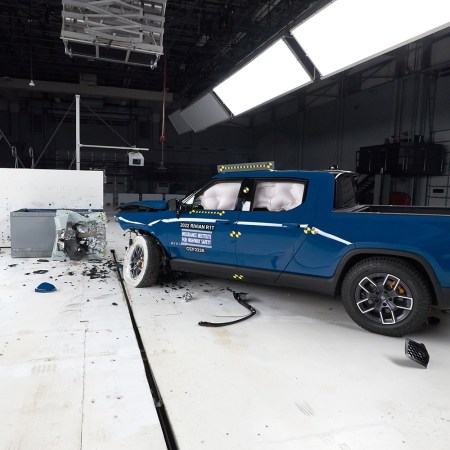Middle-aged men fantasize about some pretty strange things. I don’t mean sports cars and triathlons, but truly weird stuff like raising pet hamsters and vintage swimwear. Some people call these preoccupations a mid-life crisis, but in many cases, I think this is wrong. There comes a time when a lot of men have achieved a solid level of success with work and family, and so have the opportunity to focus on their own needs, in terms of time and money. That’s not a crisis at all, but an adjunct of accomplishment. A pattern I’ve noticed is how many chaps in their late thirties and forties return to things that made them happy as boys, or that age and money once restricted to posters tacked up on a bedroom wall.
For me, it’s always been hamsters — er, I mean trucks. The bigger the better. When I’m on the freeway to visit my mother-in-law, what a thrill to see the big rigs with their chrome pipes, suspension seats and long noses veiling more horses than a Budweiser commercial. And best of all, those tiny orange lights spaced neatly on the bodywork just over the windshield. A truck for me is the epitome of safety and freedom — two things that don’t often go together at any age.
While a trucker I might never be, a pickup truck is certainly within the scope of what’s possible. When I mentioned to my wife the idea of getting one as our next vehicle, she balked. We live in the city, where every inch of space comes at a price. But as a Brit, raised in the mountains of North Wales, pickup trucks still embody my American dream — specifically the romantic idea of driving cross-country (Cannonball Run style) and camping (especially in winter) in any of this country’s fantastic national parks.
But why drive a truck year-round for a once-yearly excursion?

My wife’s raised eyebrows were not unfounded. For instance, we’re all in the midst of an environmental nightmare, so why add to the problem and not the solution? Also, the Federal Highway Administration reported that pedestrians who are struck by a large SUV are twice as likely to die as those struck by a car. Furthermore, my work as a writer, shifting mountains of text and wading through rivers of run-on sentences, certainly does not require a 5.7L Engine with part-time 4WD that gets 14 miles to the gallon.
So to get a taste of what it would be like to own a pickup truck in New York City (as a daily driver and not a work vehicle), I borrowed one for about two weeks. Specifically, the 2020 Toyota Tundra 4×4, 1794 Crewmax Edition. If my current vehicle, a 2015 Volvo XC70 T6, is Bruce Banner, the Tundra is Hulk.
With all the options, including TRD off-road package, running boards and spray-on bed-liner, the “Voodoo Blue” truck I drove comes in just over $55k. It’s too complicated to go into how that price compares with other trucks, as everyone values different packages and options. But let’s just agree it’s at the high end.
The Tundra qualifies as a half-ton truck, which refers to its payload being around 1,000 pounds. This is the size truck I wanted to test. It’s the most popular category of pickup truck in America, and when you bump up to the the three-quarter-ton trucks, the ride can be a bit rough unless there’s something heavy behind it, like, say, a prefabricated log cabin.
As my daily driver, I was going to use the truck for everything the Volvo would normally handle, such as driving kids to school, the ghastly, weekly Whole Foods run, airport pickups and day-trips to the countryside.
My wife was skeptical. She didn’t think it would even fit in the open parking space we rent behind our building in Williamsburg. Thankfully, she was in Miami when the truck was delivered, and missed the embarrassing 20 minutes it took me to park the beast perfectly in our assigned spot — so the knobbly off-road tires were an inch inside the white lines on either side.

This was my first lesson, which says more about my driving skills than the truck, as the Tundra is only six inches wider than the Volvo. The next morning, I drove my daughter five miles to school as normal. This was going to be a big part of the test, as often I have to squeeze past double-parked TLC vehicles, or trucks making AM deliveries. I also had to be hyper-aware of pedestrians, given the chilling statistics I referenced earlier.
However, pulling out of the parking lot, I learned something I never would have known from staring at numbers on paper. Namely, that sitting over a foot higher in a vehicle with way more glass than my Swedish wagon gave me significantly more visibility. I could see over parked cars to check for cyclists, and even glance over the parking lot fence for joggers and dog-walkers. This was also the case at crosswalks and dangerous two-way (instead of four-way) stops. The statistic involving pedestrian deaths and trucks/large SUVS might have less to do with the vehicle’s design, and more with the personality of drivers attracted to this class. In my case, I felt it was much less likely that I would hit a pedestrian and cyclist, because I had such a greater range of vision.
But how about squeezing passed the stationary Uber? It wasn’t easy. The extra six inches did make a difference, and without the Tundra’s parking sensors, I would have struggled. It takes time to get used to the behemoth’s dimensions. Perhaps after a month, it would have been a breeze, with or without the guiding beeps. When I simply couldn’t fit, however, I avoided the usual honk-fest, since most drivers couldn’t see over the truck, and thus didn’t know why traffic had stopped moving.
In fact, during the time I drove the Tundra, no one honked at me. My teenage daughter said it was because people thought we were Trump supporters. The New Jersey plates probably didn’t help here. However, I think it was because New Yorkers saw the truck as more of a friendly utility vehicle, with the sort of driver who’s always willing to lend a hand. In the two instances I’ve broken down in recent memory (once in the Hamptons and once outside Louisville, KY), it was indeed pickup truck drivers who stopped both times, resulting in friendly tows to the nearest gas station.
While driving the Tundra, I also never had a problem merging into lines of cars crawling toward an exit; people slowed down and let me in. In other vehicles I’ve tested, the opposite has happened — my presence on the road in a particular car brewed a collective disdain with other drivers. One big test came with picking my wife up from the JetBlue terminal at LGA.
“Oh my God,” she said, on spotting it in the short-term parking lot. Not promising.
However, once inside, she warmed to Toyota’s biggest offering in this category, and even began to like it. The main cabin is massive, incredibly comfortable, elegant, and the ride is smooth — not what most people think of when they imagine riding shotgun in a truck.
While I didn’t get the opportunity to really drive long distance, we did take the Tundra to the south shore of Long Island, during which I relished what I love so much about trucks: an elevated cab, a powerful motor and miles of open highway.
The true test of practicality, however, came when it was time to drive to Whole Foods, where the free parking is in an underground garage with height restrictions. As I had figured, we were fine in a half-ton truck, but a three-quarter-ton vehicle would have made it neither under the floating bollards nor around the pillars once underground.
Some of the delivery vans were not much smaller than the Tundra, but I did feel a wee bit silly, loading grocery bags of vegan sausages and gluten-free bread into a truck bed built for things like rock, dirt and aircraft-engine parts.
By the end of the two weeks, my daughter loved the Tundra, and was already planning a road trip where I would drive her friends to a Marilyn Manson concert in Hershey, PA. Even my wife had positive things to say. She felt safer in the pickup cab than in our wagon, and even talked about an August road trip to Quebec — though without the luxurious 1794 edition interior, I’m not sure the response would have been as positive.
In summary, owning a pickup in the city is not much different from having a Range Rover or Cadillac Escalade, in terms of size. And if you’re into mountain biking, kayaking, dirt-biking or any sport where there’s equipment and mess, a truck is decidedly a very good option.
However, in my experience, there are three things that are essential to your beloved pickup truck not becoming a headache. They are, in no particular order: parking sensors, a truck bed-cover (to deter litter bugs and thieves), and perhaps most important of all, a designated parking space. Driving around looking for a spot big enough for a vehicle four feet longer than an Audi A4 would be something of a fool’s mission.
Although the Tundra 1794 Crewmax doesn’t have the lighter, aluminum body of the Ford F150, it does have an incredibly beautiful interior: brown leather, suede and wood trim. It also comes in fantastic colors that make the vehicle much more interesting than other half-ton trucks, most of which only come in standard construction-site colors. In terms of safety, the Tundra is inferior to Ford’s F-150, which deals better with frontal collisions. The headlights on both models, however, are equally crap.
Unless you were planning on buying a Prius, a Tesla or small car, the impact on the environment is not that much different (if at all) from any SUV. So if your job or family situation requires you to drive over 50 miles in one shot once or twice a week, I think a pickup truck would be a terrific choice — that is, if you would favor something like the Tundra over a Lexus LS or Mercedes S class, as I would.
For my daily school runs, the monthly ski/surf/climbing trip and a yearly extreme camping trip, however, my current Volvo works well enough. But it’s not a car for which I will ever have any real enthusiasm — unlike a truck.
This article was featured in the InsideHook NY newsletter. Sign up now for more from all five boroughs.






















